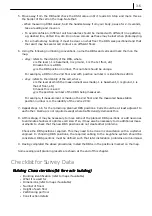
1–4
Chapter 1
DECT System Overview
Handover
Handover
Handover
Handover
This is a function/procedure that handles the physical channel changes between slots or cells. To
make a seamless handover between a DBS and a handset, a new channel needs to be set up and a
connection made using the new channel. At this point, both new and old channels are used simulta-
neously. After establishing the new connection, the old connection is broken.
Handover request is initiated by the DECT handset. Therefore, adequate cell-site design for the DECT
handsets being used is essential for seamless handover.
Roaming
Roaming
Roaming
Roaming
When a DECT user moves around, the DECT handset searches for a DBS with the strongest sig-
nal and registers its location with that DBS even though it may not be making or receiving any
calls. Due to this registration, the precise location of each of the handsets is known at all times.
Therefore, all incoming/outgoing calls are processed without any loss of connection within the RF
coverage area. If the user has a valid registration with other systems, inter-system roaming can be
made available.
Voice Quality
Voice Quality
Voice Quality
Voice Quality
The 32kbps ADPCM voice coding standard is used in DECT. The digitally coded voice is
transmitted between the DBS and the DECT handset. DECT uses a muting method to remove the
noise caused by lost data and RF propagation conditions. The DECT handset continuously looks
for the best time slot and frequencies from the available time slots and frequencies. This is called
Dynamic Channel Selection (DCS). Digital Signal Processing (DSP) on the DBS performs echo-
cancellation/suppression to reduce the echo caused by the analogue trunk line and PSTN net-
work. In addition, the DBS has two antennas and the stronger signal is selected for communica-
tion. In addition, the antenna on which the DBS received the stronger signal is used for the for-
ward link.
Synchronisation
Synchronisation
Synchronisation
Synchronisation
Under multi-cell configuration, all DBSs must maintain the same RF transmit timing for handover
because DECT is working under Time Division Multiple Access (TDMA). The system can distribute
the timing information to all DBSs for multi-frame data signalling. DCS does not support an ex-
ternal synchronisation port.
Other Functions
Other Functions
Other Functions
Other Functions
!
Registration/De-registration of DECT handset.
!
Making a call to/from DECT handset.
!
Location registration.
!
Handover / Internal handover (Inter-cell /Intra-cell handover), Connection/Bearer handover.
!
Management of DBS and handset.
!
Additional features (supports DECT Frame SYNC/ Multi-Frame SYNC, etc.)
Summary of Contents for Office DECT 8000
Page 1: ...SAMSUNG Office DECT 8000 Installation and Programming Manual ...
Page 64: ...6 10 Chapter 6 Maintenance ...
Page 65: ...6 11 ...
Page 66: ...6 12 Chapter 6 Maintenance ...
Page 67: ...6 13 ...
Page 68: ...6 14 Chapter 6 Maintenance ...
Page 69: ...6 15 ...
Page 70: ...6 16 Chapter 6 Maintenance ...











































